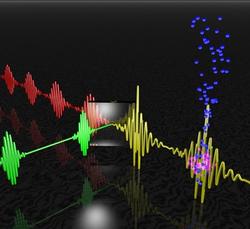Electron movie
CFEL's DESY research published in the August edition of Nature Photonics
Franz Kärtner's research published in August nature photonics:
New technologies in laser pulses lasting quintillionths of a second could make it possible to film the electron motion during chemical reactions.
In a paper published in the latest issue of Nature Photonics, a team of researchers led by Prof. Franz X. Kärtner of CFEL-DESY and MIT demonstrates a new important step in the challenge of making movies of individual electrons. Due to the unprecedented capabilities in generating attosecond pulses, this approach may result in recording time sequences of electrons interacting during chemical reactions, with applications to basic sciences, biology, electronics and medicine.
The researchers are from MIT’s Research Laboratory of Electronics, CFEL-DESY, the University of Hamburg, the University of Sydney and Politecnico di Milano. This new approach in the generation of ultrashort pulses with femtosecond (millionths of billionths of seconds) durations will lead in the future to the generation of attosecond (billionths of billionths of seconds) pulses that can be used to capture the motion of electrons in the attosecond timescale. Attosecond pulses are the new frontier in ultrafast optics, since this time unit corresponds to the time scale on which electrons significantly move inside and outside atoms.
Pulse synthesis
These ultrashort pulses were generated through the synthesis of two pulses already very short to begin with. Counter intuitively, the sum of short pulses can be even shorter than the individual pulses, if they have different frequencies and the appropriate phase between the two electromagnetic fields. This is because fields are regular waves, with sequences of crests and troughs, and the main crests of the fields can sum up while the secondary crests of one wave are canceled by the troughs of the other waves, resulting in an overall shorter sum than the addends. This can be seen by summing up two or more sinusoids with multiple frequencies among each other, like for example sin(t), sin(2t), sin(3t) etc. where t is time. The more sinusoids of this kind you sum up, the shorter and the cleaner the pulses will be.
In the work published in Nature Photonics the researchers first built two pulse sources at different frequencies in the infrared, starting from the same laser and exploiting some nonlinear optical effects. These effects occur in crystals when excited with intense light. The two pulses were already very short, i.e. they were already the sum of many sinusoids. After building the two sources, the researchers synthesized them, i.e. they summed them up with the correct phase obtaining extremely short pulses.
This was possible by using two pulses at different wavelength generated from the same initial laser. In this way they are naturally synchronized, and a slow feedback control was implemented to correct for the environmental variations due to temperature and humidity changes and acoustic vibrations.
Path towards even shorter pulses
The next step of the experiment will be to boost the energy of the synthesized pulses by amplifying them. This should be possible, even if it poses some engineering challenges due to the very high energies involved. Afterwards it will be possible to excite gas atoms to produce even shorter pulses, in the attosecond regime. This is possible because the electrons in the gas atoms are accelerated by the pulse; they increase their energy and release it in form of radiation in the XUV spectral range, leading to the production of attosecond pulses. Attosecond pulse generation has already been demonstrated, but the new source will enable to explore new regimes in this technique, and finally make it possible to observe the movement of electrons during chemical reactions.
CFEL Publications
